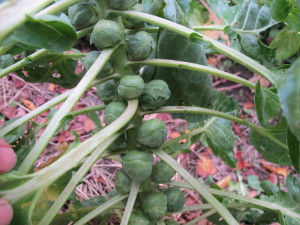Cold Weather Crops
At this time of year I eat one of the “three B’s” from my garden every day: broccoli, Brussels sprouts or kale. All right, don’t get on my case. I know kale doesn’t start with a “B”. But it’s a brassica, the family that contains those other two, plus cabbage, rutabagas, cauliflower, kohlrabi and more. All are good cold weather crops.
In addition to surviving frosts, all the brassicas are healthy foods with lots of Vitamin C, soluble fiber and compounds thought to prevent cancer (though that is a little controversial). What you may not know is that boiling brassicas removes most of those cancer-fighting compounds, but steaming them or cooking them in a microwave dos not. Three to four minutes of steaming will cook your brassica nicely, but not steal many nutrients. But the best way to eat them is raw.
There are many varieties of broccoli, almost all are excellent. Arcadia is one that has done well for me, and is very cold hardy. I talked to my friend Chaz Meyers of Cornish Flat, N.H., who I think of as Mr. Broccoli. He and his wife, Jill Johnson, grow about 50 plants every year, freezing it and eating it all year. He told me that ‘Packman’ is favorite, in part because it produces lots of side shoots. He also likes ‘Waltham’ and ‘Gotham’ varieties.
Chaz recommends cutting the primary head of broccoli on an angle so that the stem, which is often a bit hollow, does not hold water (which might promote rot). He also suggests, if the summer is dry, watering your broccoli well after cutting the big head. That keeps the plant healthy and promotes the development of side shoots.
I once planted a little vegetable garden for a woman who didn’t know much about gardening. I planted two broccoli plants that produced magnificent heads in July. She ate them, with glee, and then pulled out the plants. Yikes! I regretfully explained that the most productive part of the plant are all those little “side shoots” that come after the main head. That, like the Energizer Bunny, broccoli keeps on producing for months. I’m still eating side shoots from plants I put in back in June.
Although broccoli are known for having little green caterpillars on them, mine have not had any this year – or none that I’ve seen. Maybe I’ve eaten a few. The best solution to the green caterpillar problem is just to soak the broccoli in cold water with a little salt in it before cooking. They will float up.
I dare say that my Brussels sprouts are perfect right now. Each is the diameter of a quarter- or a half dollar – and unbothered by any pests or diseases. I eat some every night for dinner: a dozen is just the right sized serving for me, so my six plant will keep me eating them for weeks. Brassicas are very hold hardy, and Brussels sprouts and kale will survive temperatures down to 20 degrees – or even colder. Frost helps to sweeten up their flavors.
Deer don’t bother my garden until it gets cold. Then they look for my Brussels sprouts and kale and broccoli. Once they waited until the night of December 24 to eat my Brussels sprouts, though that might have been the reindeer, waiting while Santa was inside the house. I recently took some preventive measures. I covered my kale with a scrap of chicken wire that I just draped over my plants, and then I surrounded the Brussels sprouts with some four-foot chicken wire. The broccoli will have to fend for itself – I’ve run out of fencing.
Kale is the perfect vegetable to freeze. Unlike spinach, it doesn’t get soggy when frozen. It keeps its character. I blanch it for a minute in boiling water. That kills the aging enzymes that would make it turn old and woody after just a few months in the freezer. When I take it out, I drop it into a sink full of cold water, spin it dry in my salad spinner, pat it dry with a tea towel, and put it in freezer bags. I suck out the air in the bags with a drinking straw. The straw goes into a zipper bag that is 99% closed, and I suck out the air. I snap the bag shut as I pull out the straw, and it’s ready to go in the freezer.
I know people that are gaga about kale chips, dried kale that is salty and crispy, the health-nut food to substitute for potato chips. I recently tried making my own but I’m neutral about them. Here’s what I did: I stripped the leaves off the central stem, and tore the leaves into pieces and put them in a big bowl. I coated them with a garlic and olive oil solution (I used 3 cloves garlic and a few tablespoons of oil). I sprinkled pepper flakes or nutritional yeast on the leaves and tossed some more. I added salt, but not a lot.
Then I put some kale chips in the oven at 150 degrees for 2 hours with the convection fan blowing, others in a food dehydrator at 135 degrees for 2.5 hrs. Maybe I needed to use more salt or oil, but I was aiming for a health food. And this tasted like something a little too healthy. Oh well. They’re crispy, but they’re definitely not as good as potato chips. Darn!
Eating the brassicas from my garden at this time of year is a wonderful way to transition to winter. I have food in the freezer from the summer, and root crops stored in the cellar. But it feels great to walk to the garden with a knife and cut something fresh for dinner.
Henry Homeyer is a gardening educator, speaker and writer. Reach him at henry.homeyer@comcast.net.



